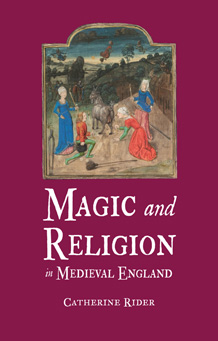
Book cover
Medieval New Year resolutions both a blessing and a blaspheme
The custom of making resolutions for the New Year goes back to the Medieval period.
As the year end approaches, a University of Exeter historian has shed light on how the future was predicted centuries ago.
The research shows how the Christian clergy supported agricultural superstitions but condemned what they perceived as magic rituals.
The day of the week on which Christmas or New Year fell was used as an indicator to tell how the year would turn out. According to one set of predictions, if Christmas Day fell on a Sunday, then Lent would be windy, summer would be dry, vines would flourish and honey would be abundant. But if Christmas Day fell on a Monday, the summer would be windy and the vines would wither. At a time when farming was the most prominent industry and focus of the economy, the way people responded to predictions like these could mean the difference between a prosperous year and a hungry one.
Research for Dr Catherine Rider‘s book ‘Magic and Religion in Medieval England’ found that the Medieval clergy did not generally disapprove of this kind of fortune telling. They accepted that it really was possible to predict the weather and the harvest in advance. New Year predictions like these were a kind of science, not magic. They may appear like the ancestors of modern weather forecasting, even if the methods don’t seem reliable by modern standards.
Dr Rider explained:“We can see how acceptable the Christmas Day predictions were by looking at the manuscripts of the day. Even in documents written to educate the clergy these superstitions appear alongside notes on how to hear confessions, the Seven Deadly Sins and short moral stories.
She added: “However, medieval priests were not so willing to accept all New Year traditions. Magic offered many other possibilities for predicting the future, but the clergy believed this was against God. Although they accepted those rooted in agriculture, others were considered blasphemous.“
Research showed that the 13th century theologian Richard of Wetheringsett complained about people who exchanged gifts called hounsels with their neighbours. He objected because these gifts weren’t just tokens of friendship but were believed to bring good fortune to both the giver and the receiver over the coming year. People also put beans near the fire in order to predict how their plans for the year would turn out, or threw shoes over the roof beams of their house to predict whether anyone in the house would die in the coming year - as related by 14th century monk and scholar Ranulph Higden who described various New Year rituals with caution.
But it was risky to give such detail in sermons in case it gave the listeners ideas. Writing a sermon for New Year’s Day in around 1400, the preacher John Mirk was nervous about the public appeal of such rituals and avoided describing the superstitions in his sermons. Unlike the predictions of the weather or the harvest, these rituals caused concern because they tried to identify the fortunes of individual people, which were known to God alone. Any attempt to pry into this was deemed as magic.
Research shows that despite the best efforts of medieval preachers, New Year magic was very difficult to stamp out. Such traditions still endured centuries later, because of burning desire to know what the coming year will bring. That yearning for advance knowledge of greater success of a change in fortunes remains of interest today.
Date: 20 December 2012
